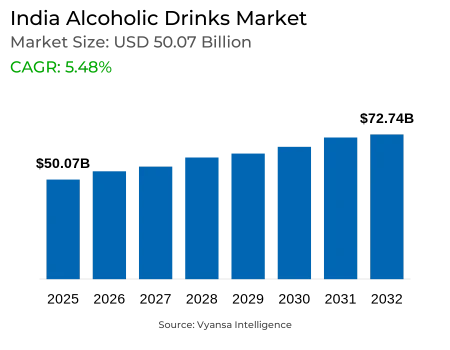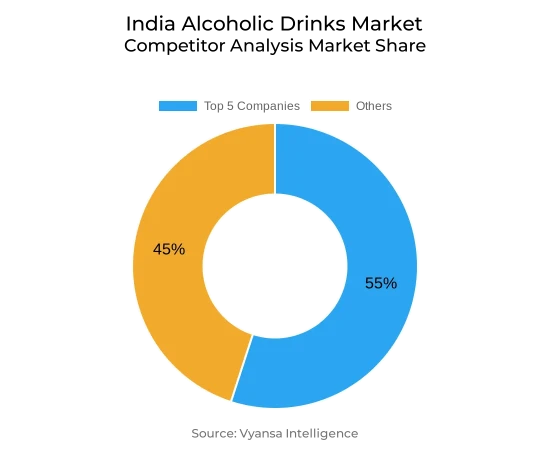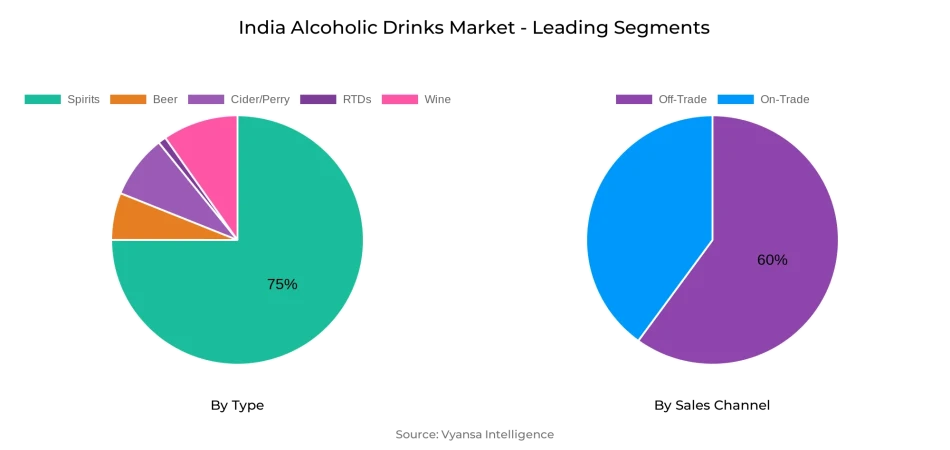
India Alcoholic Drinks Market Report: Trends, Growth and Forecast (2026-2032)
By Type (Beer, Cider/Perry, RTDs, Spirits, Wine), By Alcohol Content (High, Medium, Low), By Flavor (Unflavored, Flavored), By Packaging Type (Glass Bottles, Tins, Plastic Bottles, Others), By Sales Channel (On-Trade, Off-Trade (Retail Offline, Retail Online))
- Food & Beverage
- Oct 2025
- VI0451
- 130
-




India Alcoholic Drinks Market Statistics and Insights, 2026
- Market Size Statistics
- Alcoholic Drinks in India is estimated at $ 50.07 Billion.
- The market size is expected to grow to $ 72.74 Billion by 2032.
- Market to register a CAGR of around 5.48% during 2026-32.
- Type Shares
- Spirits grabbed market share of 75%.
- Spirits to witness a volume CAGR of around 2.23%.
- Competition
- More than 10 companies are actively engaged in producing Alcoholic Drinks in India.
- Top 5 companies acquired 55% of the market share.
- Inbrew Beverages Pvt Ltd, Allied Blenders & Distillers Pvt Ltd, Radico Khaitan Ltd, Heineken NV, Diageo Plc etc., are few of the top companies.
- Sales Channel
- Off-Trade grabbed 60% of the market.
India Alcoholic Drinks Market Outlook
India Alcoholic Drinks Market is projected at $50.07 billion in 2025 and is forecast to rise to $72.74 billion by 2032. Off-trade continues to be the leading sales channel, with 60% of the market, as driven by grocery retailers, large-format stores, and Vinmonopolet-style stores selling premium products and sampling opportunities. Convenience, accessibility, and product variety will remain drivers of off-trade growth, with on-trade outlets set to gain from social events and city lifestyle trends.
Spirits will remain market leaders, growing over half the overall volume, while whisky will still be the best-selling category. Spirits will see a volume CAGR of approximately 2.23% through the forecast period, led by an expanding middle-class population, growing premiumisation, and growing popularity for Indian-made single malts. Whisky off-takes, both domestic and imported, will continue to grow as end userss look for niche and experience-based products.
Beer and wine will undergo steady growth with low per capita consumption and enhanced attention to premium and flavoured offerings. Firms are expected to pitch more to younger end users through milder and flavoured beers, as well as imported wines, especially from Australia, Italy, and France. The expanding Millennial and Gen Z segment will also drive experimentation on alternate and premium choices, such as craft beers and single malts.
Retail innovation, premiumisation, and health-oriented consumption will dictate market trends throughout the forecast period. Inflation and state-controlled taxation are still challenges, but those manufacturers who target premium products, optimize distribution, and interact with customers through digital channels will gain. Generally, the market will experience vigorous growth, fueled by demographic strengths, changing tastes, and rising end users availability throughout India.

India Alcoholic Drinks Market Growth Driver
Growing Young end users Base
India extensive and young population propels the growth of the Alcoholic Drinks Market market. Owing to a large percentage of Millennials and Gen Z reaching drinking age every year, there is a consistent stream of potential buyers. Younger end users are more willing to discover new brands, tastes, and premium Alcoholic Drinks Market, giving way for businesses to increase their product range.
Whisky, beer, and Indian single malts produced locally enjoy the experimentation and novelty-seeking nature of young end users. Social media and online interaction further enhance their impact on brand choice. Businesses use this population to launch new products, targeted campaigns, and experiences. Increased young end users groups continue to drive demand and act as a long-term driver for market growth, making it a fundamental driver for India Alcoholic Drinks Market business.
India Alcoholic Drinks Market Trend
Growing Shift towards Indian Single Malts
Indian single malts are becoming popular as end users increasingly demand premium, niche, and experiential alcohol. Young, aspiring customers prefer domestically made products over conventional Scotch, revolutionizing market dynamics and changing consumption patterns towards Indian brands.
They react by introducing new Indian single malt brands and increasing domestic production. Lifestyle wants, social media trends, and increasing end users knowledge of premium products underpin the trend. As Indian single malts become popular, they drive product differentiation and push local and global brands to compete with each other. The increased demand for Indian single malts underlines a larger shift towards premiumisation and craft experiences in the market.
India Alcoholic Drinks Market Opportunity
Low Drinking and Premiumisation Potential
India comparatively low per capita consumption of alcohol is a strong growth potential. Given its young population with a large proportion of Millennials and Gen Z entering drinking age in the next few years, even small increases in consumption have the power to increase market volumes significantly.
Such opportunities can be tapped by the companies through new product introductions, growing distribution networks, and premium and innovative alcoholic drinks. Growing end users awareness, interest in good-quality brands, and emerging acceptance of both imported and domestic premium products will complement growth further. Industry players can tap the untapped potential to grab extra market share, boost consumption, and drive long-term top-line growth across categories like whisky, beer, wine, and Indian single malts.
India Alcoholic Drinks Market Segmentation Analysis

By Type
- Beer
- Cider/Perry
- RTDs
- Spirits
- Wine
The segment with highest market share under type segment is spirits, which hold 75% of the Indian Alcoholic Drinks Market. Spirits continue to be the preferred option, with whisky being at the top of the consumption chart and commanding the largest portion. Brands of Indian Made Foreign Liquor (IMFL) are especially favored, while single malts both domestic and imports are becoming increasingly popular among youth and premium-conscious end userss. Whisky, in particular, continues to lead market volumes because of its cultural appeal and established brand presence.
Spirits are anticipated to see a volume CAGR of approximately 2.23% during the forecast period, sustained by premiumisation trends, the growth of local single malts, and increasing demand for niche and experiential products. Large Millennial and Gen Z population, as well as low per capita consumption, offer huge growth opportunities. Brands are upgrading premium offerings and focusing on younger end users, fueling overall category growth and affirming spirits as the central segment of India Alcoholic Drinks Market market.
By Sales Channel
- On-Trade
- Off-Trade
The segment with the highest market share under the sales channel is off-trade, holding 60% of the Indian alcoholic drinks market. Grocery retailers, large-format stores, and specialty outlets dominate distribution, providing broad accessibility and convenience for everyday purchases. Off-trade channels cater to mass-market and premium spirits, as well as beer and wine, ensuring end users can access a wide range of products in a single location. Seasonal promotions and brand visibility in stores further support off-trade growth.
End users demand for on-home consumption and value remains the driving force for off-trade volume. Convenience stores, on-trade premises with premium experiences, tasting rooms, and value-added sections for various alcoholic segments enhance motivation and sales. With higher urbanisation, increasing disposable incomes, and more emphasis on premium offerings, the off-trade channel will continue to be the main Alcoholic Drinks Market volume driver in India throughout the forecast period.
Top Companies in India Alcoholic Drinks Market
The top companies operating in the market include Inbrew Beverages Pvt Ltd, Allied Blenders & Distillers Pvt Ltd, Radico Khaitan Ltd, Heineken NV, Diageo Plc, Pernod Ricard Groupe, Carlsberg A/S, Anheuser-Busch InBev NV, Mohan Meakin Ltd, John Distilleries Pvt Ltd, etc., are the top players operating in the India Alcoholic Drinks Market.
Frequently Asked Questions
Related Report
1. Market Segmentation
1.1. Research Scope
1.2. Research Methodology
1.3. Definitions and Assumptions
2. Executive Summary
3. India Alcoholic Drinks Market Policies, Regulations, and Standards
4. India Alcoholic Drinks Market Dynamics
4.1. Growth Factors
4.2. Challenges
4.3. Trends
4.4. Opportunities
5. India Alcoholic Drinks Market Statistics, 2022-2032F
5.1. Market Size & Growth Outlook
5.1.1. By Revenues in US$ Million
5.1.2. By Quantity Sold in Million Litres
5.2. Market Segmentation & Growth Outlook
5.2.1. By Type
5.2.1.1. Beer- Market Insights and Forecast 2022-2032, USD Million
5.2.1.2. Cider/Perry- Market Insights and Forecast 2022-2032, USD Million
5.2.1.3. RTDs- Market Insights and Forecast 2022-2032, USD Million
5.2.1.4. Spirits- Market Insights and Forecast 2022-2032, USD Million
5.2.1.5. Wine- Market Insights and Forecast 2022-2032, USD Million
5.2.2. By Alcohol Content
5.2.2.1. High- Market Insights and Forecast 2022-2032, USD Million
5.2.2.2. Medium- Market Insights and Forecast 2022-2032, USD Million
5.2.2.3. Low- Market Insights and Forecast 2022-2032, USD Million
5.2.3. By Flavor
5.2.3.1. Unflavored- Market Insights and Forecast 2022-2032, USD Million
5.2.3.2. Flavored- Market Insights and Forecast 2022-2032, USD Million
5.2.4. By Packaging Type
5.2.4.1. Glass Bottles- Market Insights and Forecast 2022-2032, USD Million
5.2.4.2. Tins- Market Insights and Forecast 2022-2032, USD Million
5.2.4.3. Plastic Bottles- Market Insights and Forecast 2022-2032, USD Million
5.2.4.4. Others- Market Insights and Forecast 2022-2032, USD Million
5.2.5. By Sales Channel
5.2.5.1. On-Trade- Market Insights and Forecast 2022-2032, USD Million
5.2.5.2. Off-Trade- Market Insights and Forecast 2022-2032, USD Million
5.2.5.2.1. Retail Offline- Market Insights and Forecast 2022-2032, USD Million
5.2.5.2.2. Retail Online- Market Insights and Forecast 2022-2032, USD Million
5.2.6. By Competitors
5.2.6.1. Competition Characteristics
5.2.6.2. Market Share & Analysis
6. India Beer Market Statistics, 2022-2032F
6.1. Market Size & Growth Outlook
6.1.1. By Revenues in US$ Million
6.1.2. By Quantity Sold in Million Litres
6.2. Market Segmentation & Growth Outlook
6.2.1. By Alcohol Content- Market Insights and Forecast 2022-2032, USD Million
6.2.2. By Flavor- Market Insights and Forecast 2022-2032, USD Million
6.2.3. By Packaging Type- Market Insights and Forecast 2022-2032, USD Million
6.2.4. By Sales Channel- Market Insights and Forecast 2022-2032, USD Million
7. India Cider/Perry Market Statistics, 2022-2032F
7.1. Market Size & Growth Outlook
7.1.1. By Revenues in US$ Million
7.1.2. By Quantity Sold in Million Litres
7.2. Market Segmentation & Growth Outlook
7.2.1. By Alcohol Content- Market Insights and Forecast 2022-2032, USD Million
7.2.2. By Flavor- Market Insights and Forecast 2022-2032, USD Million
7.2.3. By Packaging Type- Market Insights and Forecast 2022-2032, USD Million
7.2.4. By Sales Channel- Market Insights and Forecast 2022-2032, USD Million
8. India Ready-to-Drink Market Statistics, 2022-2032F
8.1. Market Size & Growth Outlook
8.1.1. By Revenues in US$ Million
8.1.2. By Quantity Sold in Million Litres
8.2. Market Segmentation & Growth Outlook
8.2.1. By Alcohol Content- Market Insights and Forecast 2022-2032, USD Million
8.2.2. By Flavor- Market Insights and Forecast 2022-2032, USD Million
8.2.3. By Packaging Type- Market Insights and Forecast 2022-2032, USD Million
8.2.4. By Sales Channel- Market Insights and Forecast 2022-2032, USD Million
9. India Spirits Market Statistics, 2022-2032F
9.1. Market Size & Growth Outlook
9.1.1. By Revenues in US$ Million
9.1.2. By Quantity Sold in Million Litres
9.2. Market Segmentation & Growth Outlook
9.2.1. By Alcohol Content- Market Insights and Forecast 2022-2032, USD Million
9.2.2. By Flavor- Market Insights and Forecast 2022-2032, USD Million
9.2.3. By Packaging Type- Market Insights and Forecast 2022-2032, USD Million
9.2.4. By Sales Channel- Market Insights and Forecast 2022-2032, USD Million
10. India Wine Market Statistics, 2022-2032F
10.1.Market Size & Growth Outlook
10.1.1. By Revenues in US$ Million
10.1.2. By Quantity Sold in Million Litres
10.2.Market Segmentation & Growth Outlook
10.2.1. By Alcohol Content- Market Insights and Forecast 2022-2032, USD Million
10.2.2. By Flavor- Market Insights and Forecast 2022-2032, USD Million
10.2.3. By Packaging Type- Market Insights and Forecast 2022-2032, USD Million
10.2.4. By Sales Channel- Market Insights and Forecast 2022-2032, USD Million
11. Competitive Outlook
11.1.Company Profiles
11.1.1. Heineken NV
11.1.1.1. Business Description
11.1.1.2. Product Portfolio
11.1.1.3. Collaborations & Alliances
11.1.1.4. Recent Developments
11.1.1.5. Financial Details
11.1.1.6. Others
11.1.2. Diageo Plc
11.1.2.1. Business Description
11.1.2.2. Product Portfolio
11.1.2.3. Collaborations & Alliances
11.1.2.4. Recent Developments
11.1.2.5. Financial Details
11.1.2.6. Others
11.1.3. Pernod Ricard Groupe
11.1.3.1. Business Description
11.1.3.2. Product Portfolio
11.1.3.3. Collaborations & Alliances
11.1.3.4. Recent Developments
11.1.3.5. Financial Details
11.1.3.6. Others
11.1.4. Carlsberg A/S
11.1.4.1. Business Description
11.1.4.2. Product Portfolio
11.1.4.3. Collaborations & Alliances
11.1.4.4. Recent Developments
11.1.4.5. Financial Details
11.1.4.6. Others
11.1.5. Anheuser-Busch InBev NV
11.1.5.1. Business Description
11.1.5.2. Product Portfolio
11.1.5.3. Collaborations & Alliances
11.1.5.4. Recent Developments
11.1.5.5. Financial Details
11.1.5.6. Others
11.1.6. Inbrew Beverages Pvt Ltd
11.1.6.1. Business Description
11.1.6.2. Product Portfolio
11.1.6.3. Collaborations & Alliances
11.1.6.4. Recent Developments
11.1.6.5. Financial Details
11.1.6.6. Others
11.1.7. Allied Blenders & Distillers Pvt Ltd
11.1.7.1. Business Description
11.1.7.2. Product Portfolio
11.1.7.3. Collaborations & Alliances
11.1.7.4. Recent Developments
11.1.7.5. Financial Details
11.1.7.6. Others
11.1.8. Radico Khaitan Ltd
11.1.8.1. Business Description
11.1.8.2. Product Portfolio
11.1.8.3. Collaborations & Alliances
11.1.8.4. Recent Developments
11.1.8.5. Financial Details
11.1.8.6. Others
11.1.9. Mohan Meakin Ltd
11.1.9.1. Business Description
11.1.9.2. Product Portfolio
11.1.9.3. Collaborations & Alliances
11.1.9.4. Recent Developments
11.1.9.5. Financial Details
11.1.9.6. Others
11.1.10. John Distilleries Pvt Ltd
11.1.10.1. Business Description
11.1.10.2. Product Portfolio
11.1.10.3. Collaborations & Alliances
11.1.10.4. Recent Developments
11.1.10.5. Financial Details
11.1.10.6. Others
12. Disclaimer
| Segment | Sub-Segment |
|---|---|
| By Type |
|
| By Alcohol Content |
|
| By Flavor |
|
| By Packaging Type |
|
| By Sales Channel |
|
Research Methodology
This study followed a structured approach comprising four key phases to assess the size and scope of the electro-oxidation market. The process began with thorough secondary research to collect data on the target market, related markets, and broader industry context. These findings, along with preliminary assumptions and estimates, were then validated through extensive primary research involving industry experts from across the value chain. To calculate the overall market size, both top-down and bottom-up methodologies were employed. Finally, market segmentation and data triangulation techniques were applied to refine and validate segment-level estimations.
Secondary Research
The secondary research phase involved gathering data from a wide range of credible and published sources. This step helped in identifying industry trends, defining market segmentation, and understanding the market landscape and value chain.
Sources consulted during this phase included:
- Company annual reports, investor presentations, and press releases
- Industry white papers and certified publications
- Trade directories and market-recognized databases
- Articles from authoritative authors and reputable journals
- Gold and silver standard websites
Secondary research was critical in mapping out the industry's value chain and monetary flow, identifying key market segments, understanding regional variations, and tracking significant industry developments.
Other key sources:
- Financial disclosures
- Industry associations and trade bodies
- News outlets and business magazines
- Academic journals and research studies
- Paid industry databases
Primary Research
To validate secondary data and gain deeper market insights, primary research was conducted with key stakeholders across both the supply and demand sides of the market.
On the demand side, participants included decision-makers and influencers from end-user industries—such as CIOs, CTOs, and CSOs—who provided first-hand perspectives on market needs, product usage, and future expectations.
On the supply side, interviews were conducted with manufacturers, industry associations, and institutional participants to gather insights into current offerings, product pipelines, and market challenges.
Primary interviews provided critical inputs such as:
- Market size and revenue data
- Product and service breakdowns
- Market forecasts
- Regional and application-specific trends
Stakeholders consulted included:
- Leading OEM and solution providers
- Channel and distribution partners
- End users across various applications
- Independent consultants and industry specialists
Market Size Estimation and Data Triangulation
- Identifying Key Market Participants (Secondary Research)
- Goal: To identify the major players or companies in the target market. This typically involves using publicly available data sources such as industry reports, market research publications, and financial statements of companies.
- Tools: Reports from firms like Gartner, Forrester, Euromonitor, Statista, IBISWorld, and others. Public financial statements, news articles, and press releases from top market players.
- Extracting Earnings of Key Market Participants
- Goal: To estimate the earnings generated from the product or service being analyzed. This step helps in understanding the revenue potential of each market player in a specific geography.
- Methods: Earnings data can be gathered from:
- Publicly available financial reports (for listed companies).
- Interviews and primary data sources from professionals, such as Directors, VPs, SVPs, etc. This is especially useful for understanding more nuanced, internal data that isn't publicly disclosed.
- Annual reports and investor presentations of key players.
- Data Collation and Development of a Relevant Data Model
- Goal: To collate inputs from both primary and secondary sources into a structured, data-driven model for market estimation. This model will incorporate key market KPIs and any independent variables relevant to the market.
- Key KPIs: These could include:
- Market size, growth rate, and demand drivers.
- Industry-specific metrics like market share, average revenue per customer (ARPC), or average deal size.
- External variables, such as economic growth rates, inflation rates, or commodity prices, that could affect the market.
- Data Modeling: Based on this data, the market forecasts are developed for the next 5 years. A combination of trend analysis, scenario modeling, and statistical regression might be used to generate projections.
- Scenario Analysis
- Goal: To test different assumptions and validate how sensitive the market is to changes in key variables (e.g., market demand, regulatory changes, technological disruptions).
- Types of Scenarios:
- Base Case: Based on current assumptions and historical data.
- Best-Case Scenario: Assuming favorable market conditions, regulatory environments, and technological advancements.
- Worst-Case Scenario: Accounting for adverse factors, such as economic downturns, stricter regulations, or unexpected disruptions.
Partnering With Industry Leaders to Drive Growth
Our mission is to deliver intelligence that matters. By combining data, analysis, and industry expertise, we enable organizations to make smarter, faster, and more impactful decisions. Whether it’s a Fortune 500 company or a high-growth startup, businesses trust us to provide clarity in an ever-evolving marketplace.






